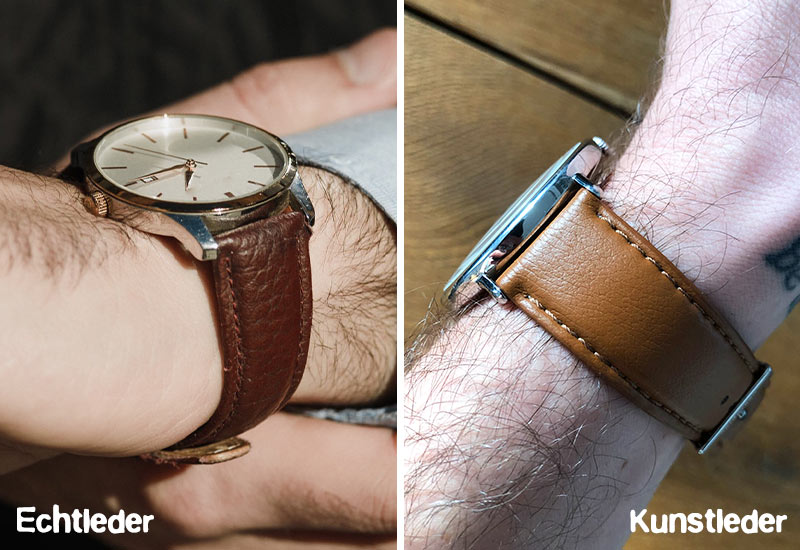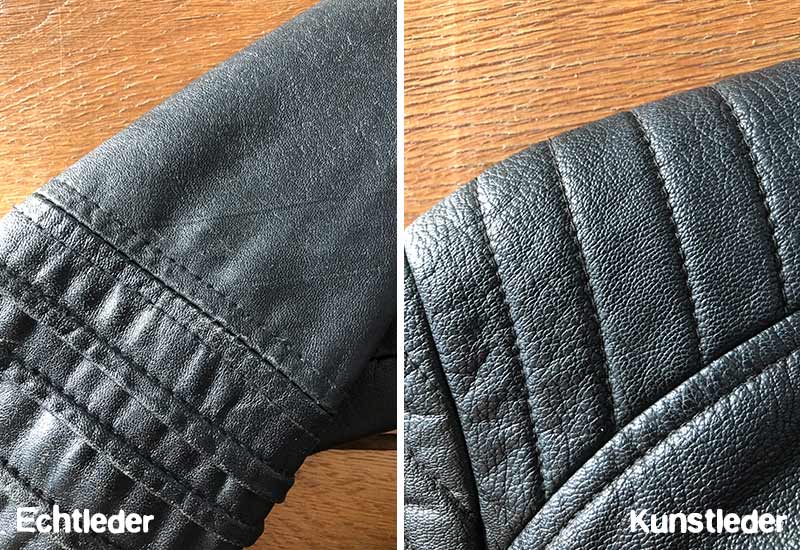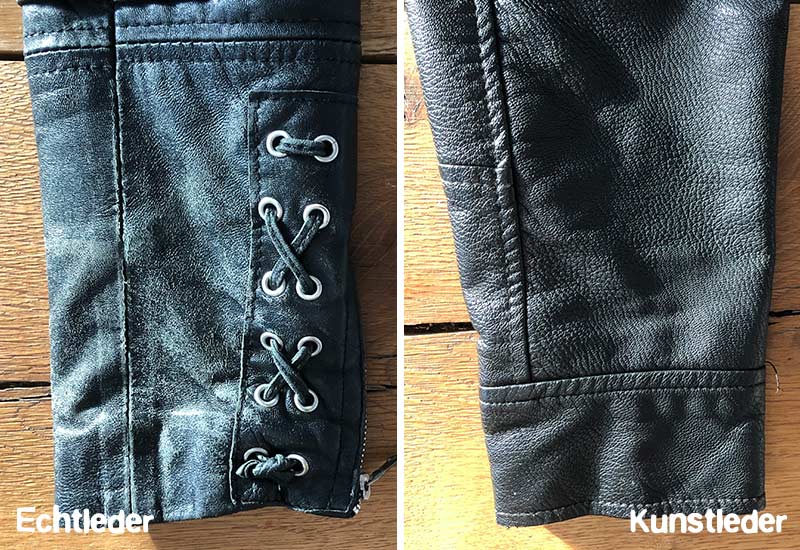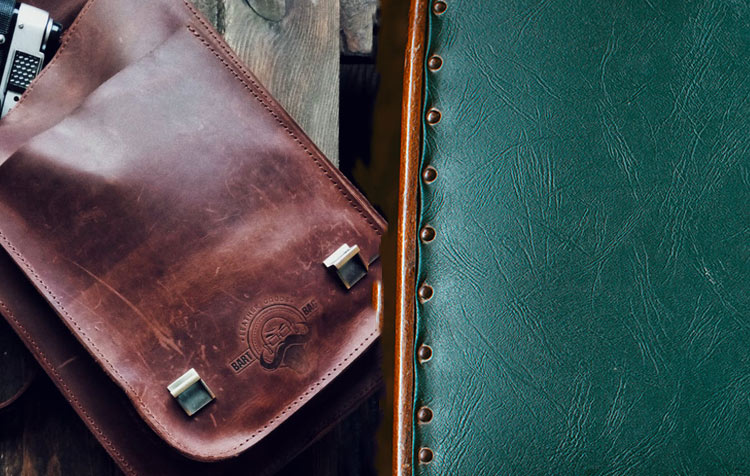Want to learn to tell the difference between genuine leather and faux leather? Then you are absolutely right here! Whether it's a wallet, seat cover, handbag, wristwatch or shoe - today it's difficult to tell the difference between genuine animal and alternative, plant-based leather goods. But even if they are very similar at first glance, a closer look - and with the help of a few tips - reveals significant differences.
In this article, I would now like to explain to you how you can recognize genuine leather and imitation leather. Let's go!
In advance you can find here already a Overview about my advice:
- View structure
- Smell
- Feel
- View labels and signs
- Test with oil and water
- Look at the price
- Observe changes
- Ask seller
Why should I distinguish real and artificial leather at all?
Maybe you just landed on this page to make sure that the object of your desire is really genuine leather. Then I would like to give you here briefly and concisely the vegan motives for preferring non-animal leather alternatives. introduce
- Countless animals have to suffer for the production of genuine leather goods
- Leather is more than "just" a waste product of the meat industry
- Wearing leather suggests acceptance of animal exploitation
- The tanning process is extremely harmful to the environment
- Countless people also have to suffer for leather
- …
You can find this list and all the more detailed explanations of the reasons mentioned in the article "Why don't vegans wear leather?".
7 vegan tips to quickly identify and avoid genuine leather
Now you know that vegan leather should be preferred mainly for ethical and ecological reasons, if you don't want to do without the leather look altogether. But now directly to the promised tips to distinguish the animal-friendly "fake leather" and real leather as quickly as possible.
1. view structure

The surface itself can now be imitated quite well in terms of appearance. However, an indication of genuine leather are minor flaws in the surfacewhich occur, for example, due to injuries or neck wrinkles of the animal. Imitation leather, on the other hand, is produced uniformly "perfect" by machines.
Your scrutinizing gaze should therefore definitely be the Cut edges of the respective product apply. If you see a weave, smooth edges or multiple layers of material there, it's usually artificial, vegan leather, as genuine leather usually has a fibrous structure. The reverse side also provides clues: animal-friendly fake leather has a woven layer and fine, soft fibers - genuine leather is rather rough.₁
2. smell
Surely you know the typical, distinctive leather smell of car seats or new shoes. Although this can be imitated by artificial aromas, it is usually a clear indication of genuine leather. Is the object of desire rather neutral in odor or does it smell of Plasticthen it is more likely to be an imitation leather.
Good to know: If you lightly burn a leather product - and it smells like burnt hair - it is very likely to be genuine leather. Unfortunately, this test usually harms the product.
3. feel

Animal leather adjusts to the ambient temperature much more slowly than artificial leather. So if the material is relatively cool in warmer environmentthis is also a good indication that it is genuine leather. Since the latter is also breathable, you can theoretically tell the difference between the two materials by their wearing comfort. Basically genuine leather also softerwhile imitation leather comes across as rather rigid.
Another, personal observation: Animal-friendly leather usually feels a bit lighter and thinner.
4. view labels and signs
If you want to distinguish genuine leather from imitation leather, a look at the label, advertising poster or price tag will usually help. Animal leather goods usually have a confirming seal. This is a spread animal, often with the inscription "genuine leather".. A diamond in the spread animal, on the other hand, signals coated leather.
5. test with oil and water
Since genuine leather is the former skin of an animal, you can also recognize it by the fact that it is Open pores has and would partially absorb water as well as grease. Imitation leather is densely coated and usually repels such foreign substances. With a small test on an invisible part of the handbag, jacket or other leather goods, you can also distinguish genuine leather and imitation leather.
6. look at the price
Although the price is not a clear proof of whether a product is made of genuine leather or imitation leather - but a Indicator it always is. Costs a leather jacket 500€this speaks more for a genuine leather product. With prices around the 70 € is rather to be assumed from fake leather that vegans but of course not only for cost reasons will prefer.
7. observe changes

Of course, this tip can only be implemented after the purchase. Nevertheless, you can still distinguish genuine leather from imitation leather based on the aging after the fact. And how? Artificially produced leather normally retains its color, whereas Real leather fades a littleespecially at the folds. Even though it is generally easier to care for, imitation leather is more likely to develop small cracks at the creases over time, where different layers of material are likely to be visible.
8. ask salesperson
Almost forgotten! You can also just With the respective sales personnel or manufacturer ask whether a product is made of animal, artificial or vegetable leather. As a rule, this is another clear indication to distinguish genuine leather from artificial leather. At the same time, it is a chance to explain that you would have bought the product if no animal had had to suffer for it.
Distinguish animal leather and vegan leatherette - No problem!
While genuine leather is still a desirable quality feature for many people, it is now a no-go for vegans. So fake leather only sounds supposedly bad -. for animal lovers who do not want to do without leather products, however, it is just right.
I hope that with this article I was able to provide you with decisive tips for distinguishing genuine leather from imitation leather in seconds in the future. Do you have any questions or further tips? Then feel free to write me a comment!
Be always kind to animals,

PS.: Is genuine leather actually sustainable? You can find out the answer now in the linked post - enjoy!
References:
₁ PETA Deutschland e.V.: Leather or imitation leather? How to tell the difference (as of 16.08.2016), available at https://www.peta.de/themen/leder-kunstleder. [05.01.2022].






Super article about this material. It is also interesting to "recycle" leather so that it does not have to be produced every time new leather. VG
Comments are closed.